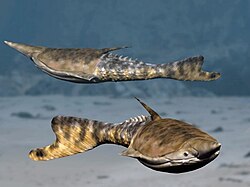A request that this article title be changed to Pteraspidomorpha is under discussion . Please do not move this article until the discussion is closed. |
| Pteraspidomorphs Temporal range: | |
|---|---|
 | |
| Pteraspis | |
| Scientific classification | |
| Domain: | Eukaryota |
| Kingdom: | Animalia |
| Phylum: | Chordata |
| Infraphylum: | Agnatha |
| Class: | † Pteraspidomorpha Goodrich, 1909 |
| Type species | |
| † Pteraspis rostrata Agassiz, 1835 | |
| Subgroups [1] | |
| |
Pteraspidomorpha is an extinct class of early jawless fish. They have long been regarded as closely related or even ancestral to jawed vertebrates, but the few characteristics they share with the latter are now considered as basal traits for all vertebrates.







